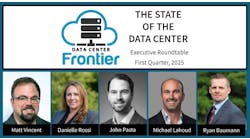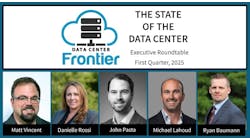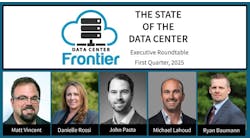Cloud computing and social media platforms have been growing fast. These "hyperscale" operators continue to grow in 2023, but at a slightly slower pace than in previous years. Since these companies are the largest customers for the data center industry, what might these growth trends mean for the future?
At DCF, we always like to ask the experts - in this case, the six seasoned industry leaders featured in our Executive Roundtable for the Second Quarter of 2023. In addition to today's discussion of the growth trends in hyperscale computing, these thought leaders will explore other relevant topics each day this week, including the state of the data center supply chain, the role of automation and new technology like AI in data center management, and what's working well in the effort to build the future workforce for digital infrastructure sector.
Here’s a look at our distinguished panel:
- Joe Goldsmith, Chief Revenue Officer at NTT Global Data Centers Americas.
- Rich Okoney, Global Operations Lead, Data Centers & Critical Environments for JLL.
- Don MacNeil, Chief Revenue Officer for EdgeConneX.
- Adam Compton, Director of Strategy for Schneider Electric.
- Dave Young, Senior Vice President of Operations for DartPoints.
- Ryan Baumann, Global Director of Sales for Kohler Power Systems.
Each day this week I’ll moderate a Q&A with these executives on one of our key topics. We begin with our panel’s take on the latest data on cloud growth and get their take on what lies ahead.
Data Center Frontier: Recent earnings reports suggest the growth rate of cloud computing has moderated slightly. What’s your take on the progress of cloud computing – the “what inning are we in” question – and what lies ahead?
Joe Goldsmith, NTT GDCA: From our perspective, we’re not seeing a slowdown. Demand from our cloud-provider clients is as high as it’s ever been. It’s less chaotic than the past two years, but there is still a lot of demand for capacity from existing and new clients.
There may have been expectations of a slowdown three to six months ago, but new technologies have been announced in areas such as AI, and all the large cloud providers are launching AI solutions and investing significantly in them. Because of that, we're seeing a lot of demand in those areas.
We are at the start of a technology push. Higher-capacity processing and graphics processing units (GPUs) for applications that are around the corner are creating more demand. Most cloud providers have been able to keep up with their current demand, buying all the capacity available and preleasing future capacity, but they haven’t yet accounted for these new applications and solutions.
We are actually seeing the expansion of cloud infrastructure requirements, particularly internationally. Moreover, additional investments are being initiated to support the rapidly growing needs associated with AI and other emerging tech – which we haven’t even begun to see the impact of this new driver. As such, we are seeing growth in digital infrastructure requirements overall. The double header - Cloud and AI.
Adam Compton, Schneider Electric: 3rd Inning, our starting pitcher just gave up a few hits. But we leave the pitcher in the game…
There is a natural ebb and flow to the data center industry, using tides as another analogy. We saw a huge tidal surge in the Covid era ’20-’22. That surge has subsided, and enterprise customers are re-assessing all the benefits of Xaas. The benefit of Opex vs Capex was intoxicating, and was highly encouraged across enterprise and SMB customers. Well now finance teams are looking at their Opex and wondering if IT went too far. I’m sure the question from finance goes something like this “are we really using all of these outsourced IT cloud capabilities you bought into over the past 3 years?”
In addition, like any business model where outsourcing is part of the value proposition, there is a loss of control by the customer. They sacrifice control over their operations for cost/expertise/peace of mind. As there is a reckoning of enterprise/SMB opex expenses in colo/cloud, a part of the equation is whether it’s worth the loss of control.
In addition to customer demand changes, there’s pressure on multi-tenant and cloud data center companies from investors – those investors could be the internal kind whereby a data center business looks at its build-out plan during a time of peak demand and low supply very differently than during a time when the opposite is true. In terms of outside investors, they were skeptical (and maybe even suspicious) of data centers as an industry, as a business for years. The Covid era changed the buildout forecast of a cloud or colo infrastructure company from 6 months visibility to 18-24 months. That’s the kind of projections outside investors like, so funding flowed to build more data centers with long leadtimes meaning they put their money down ASAP to reserve stock. Now those outside investors are seeing the enterprise customer pull back, seeing the slowing of the demand, and seeing supply chain improvements and are back to being skeptical (but no longer suspicious).
* Don’t worry, AI will be the wave that makes us forget all about the small tidal undertow we feel now.
Global enterprises and governments have migrated vast chunks of infrastructure to external data centers. If data centers are not part of your core value chain and you haven’t moved at least some of your commodity storage to an infrastructure provider, the data say you may not be able to compete as efficiently in this digitally transformed economy. In parallel, during the same time, companies leveraging cloud infrastructure have filled the list of top-10 global companies (by market capitalization) - AAPL, MSFT, GOOG, META, AMZN.
Meanwhile, each progressive generation becomes more digitally native, consuming and creating an increasing amount of content, all stored in “the cloud”, or, the data centers of the same companies. So, while many enterprises have started or completed their digital transformation with its accompanying cloud computing component, the growth of both commercial and personal data creation and preservation continues to advance rapidly.
If new forces like virtual services that are truly ready for production use and the proliferation of AI drive new storage/compute demands, we could see even a greater trajectory. We’re still in the ‘early innings’ and there’s still a lot to come, in defining how cloud computing will be further optimized in the next 3 to 5 years. Stay tuned.
Dave Young, DartPoints: Cloud computing has experienced significant growth over the past decade, transforming how businesses operate and deliver services. However, it's safe to say that we are still in the early to mid-stages of its adoption, so let's say we're somewhere around the 4th inning.
Many organizations have migrated some of their operations to the cloud, but many businesses still need to embrace cloud technologies fully. Data security concerns, lack of expertise, cost, legacy system challenges, and regulatory considerations have slowed the adoption for specific industries and organizations. However, the adoption rate will continue to increase as cloud providers enhance their offerings, increasing managed and "white glove" services and specifically tailored solutions to address these concerns.
Looking ahead, we anticipate cloud computing to continue growing. The pace may fluctuate compared to initial adoption rates, but growth, nonetheless.
Shifts in the market, changes in the workplace, economic challenges, and staffing concerns will all be significant drivers. Additionally, emerging edge and serverless computing technologies will further drive innovation and adoption in the cloud space.
Consumers are increasingly looking for providers that enhance their services with robust security offerings, business continuity, and disaster recovery planning, and affordable alternatives to expertise and staffing shortcomings.
As weather and climate conditions become more unpredictable and costly, IT leaders increasingly turn to geo-diverse cloud solutions and providers that can offer continuous services with redundant failover capabilities.
The future is bright for cloud technologies, and there are still more innings. DartPoints is ready to help organizations get in the game and prepare for what's to come.
Additionally, any increase in reliance on cloud means more data processed which leads to even more of a need for 100% uptime.
NEXT: The state of the Data Center Supply Chain in 2023.
Keep pace with the fact-moving world of data centers and cloud computing by following us on Twitter and Facebook, connecting with DCF on LinkedIn, and signing up for our weekly newspaper using the form below:












